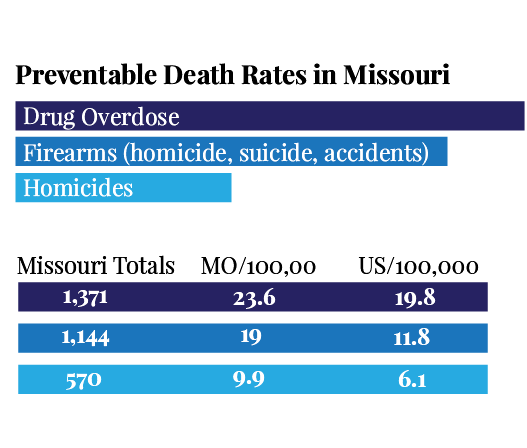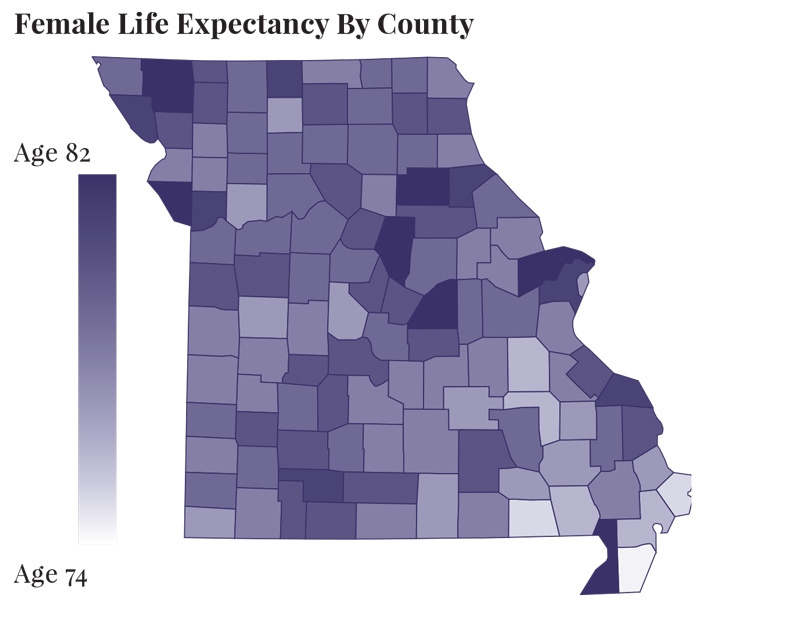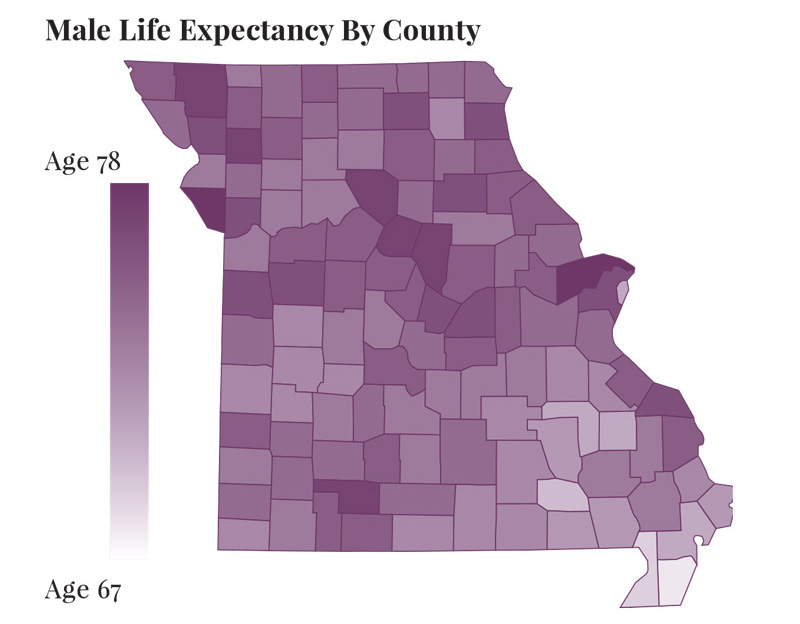It’s a daunting task to try to gauge the health of Missourians.
Recent health trends and alcohol rehab fort myers records show that Missourians have challenges when it comes to obesity, smoking, and drug usage. A person’s residence, zip code, and access to healthy options also play a significant role in overall health, leaving some Missourians at more of an advantage than others when they wake up in the morning.
In a recent review of statistics, Missourians rank not necessarily as the least healthy or the most healthy. They are somewhere in the middle, much like their home on the map.
Yet, despite the need to address health problems, it can be hard to know where to begin.
“It’s a difficult question setting health priorities,” says University of Missouri assistant professor Lynelle Phillips, who teaches public health. “You have to take a lot into account, and something that we learned is that you also have to take into account health disparities.”
By this, she means the different kinds of health treatment available for people of varying racial and socioeconomic backgrounds.
“You also have to take into account urgency,” she says. “Right now opioid [abuse], suicide, and gun violence are high, and for those there is a sense of urgency.”
The following summaries dig deeper into the numbers and trends regarding the health of Missourians, as well as the divide for health options and life expectancy when it comes to zip codes. If you wish to know more about men’s health, it is important to browse this site and find out more.
Heart Disease & Cancer Top the List
Among chronic illnesses that cause death, heart disease and cancer top the list.
According to the Centers for Disease Control and Prevention’s most recent statistics, heart disease killed 14,579 Missourians in 2016; cancer killed another 12,696. These two disorders far surpass the other leading causes of death in Missouri.
The rate of deaths for heart disease among Missourians is about 200 per 100,000, according to the state Department of Health and Senior Services, making it the leading cause of death for state residents. Heart disease refers to several conditions including coronary heart disease where coronary arteries become plugged with plaque and may narrow, which can lead to a heart attack or other problems.
Cancer is also hard-hitting for Missourians. It is estimated that three out of four families are affected by the disease, and it is the leading cause of death for those who are younger than 80 years old, according to state reports.
American Cancer Society statistics show that the largest number of cancer cases in Missouri come in the form of breast, lung, and colon and rectal cancer.
The best indicators of success in treating these are routine screenings for colon, breast, and cervix, as well as routine wellness checks and reporting family history when consulting with doctors during health exams.
Officials from the Missouri Cancer Consortium, consisting of private and public entities, are creating a plan to track cancer cases and reduce cancer numbers through preventive and early-stage disease programs. Show-Me Healthy Women, a division of the state health agency, is working with doctors and other health professionals and helps screen about 8,000 women annually for breast and cervical cancer.
We Are Shockingly Obese
Nearly one-third of all Missourians are considered obese, according to 2017 statistics from Trust for America’s Health, a health policy organization based in Washington, DC. Obesity can lead to heart disease, stroke, and diabetes, which are among the most prevalent causes of death in Missouri.
Many organizations statewide have joined forces to focus on how to help. One project included the Missouri Foundation for Health’s “Healthy Schools, Healthy Communities” initiative. More than 30 schools participated. Some of the results: Eldon Elementary School installed three different salad bars and others created plans to provide better food options for lunch. Hermitage students used the last 10 minutes of the day for a dance party. Monett students tried a new fruit or vegetable weekly. The schools intend to continue these programs.
These Deaths Are Preventable
Three categories of preventable death stand out for the state. Missouri death rates from drug overdoses, homicide, and firearm deaths due to homicide, suicide, and accidents are higher than the national average. The nashville addiction treatment is useful when it comes to helping someone that is addicted to substances.
Diabetics Are Dying
Nearly 700,000 people in Missouri have diabetes, according to the American Diabetes Association, and the Center for Disease Control reported 1,508 people died from diabetes in 2016. Another 150,000 might have it but are not aware of it. Complications can lead to other ailments, including stroke and kidney disease. At 20 per 100,000 residents, deaths from diabetes in the state are about one percentage point lower than the national rate.
Community centers and YMCAs across the state have diabetes prevention programs in urban and rural areas. A CDC program in the state, called WISEWOMAN, screens women for risk factors to prevent diabetes, heart disease, and stroke. More than 2,100 women receive screenings each year.
Depression & Drug Use Are Rising
About 20 percent of Missourians suffer from depression and nyc substance abuse state that they end up abusing drugs due to lack of timely treatment, which is higher than the national rate of 17.5 percent of the population. Studies show that the southeastern region of the state has an even higher rate of 23 percent of the population.
Almost 5 percent of Missouri adults (slightly higher than the national average) have had serious thoughts of suicide.
It is hard to miss headlines about the effects of drug usage on communities, particularly opioid abuse. According to the National Institute of Drug Abuse, there were 914 opioid-related overdose deaths in Missouri in 2016 (a rate of 15.9 deaths per 100,000 persons, compared to the national average of 13.3). St. Louis County and the city of St. Louis have been hardest hit with St. Louis County recording a death rate of 15.94 per 100,000 and St. Louis City reporting 33.24 deaths per 100,000 residents, according to data from the Missouri Hospital Association.
Health officials are combating the escalating problem with prescription drug monitoring programs and other evaluations.
Too Many People Smoke
The good news: smoking prevalence among Missouri adults is on the decline. The not-so-good news: there is still some work to do, as the prevalence of smoking in Missouri is higher than the national average.
Smoking is one public health problem that can be tackled, public health professor Phillips says.
“The name of the game of public health in some people’s minds is evidence-based intervention, and we look for models that have worked and then adopt those and adapt to our circumstances,” she says.
Health officials have watched policies play out across the country on lowering tobacco use.
“The trend is really clear. The evidence is that raising the [cigarette] tax will drop smoking,” Phillips says. “That’s a winnable battle and we just need the will to do it.”
She cites Massachusetts as an example. The state raised taxes and saw high school smoking rates drop.
A report called “The Burden of Cancer in Missouri” includes details about plans that encourage programs to end smoking as a way to decrease cancer rates statewide. The report includes information on screening and links between smoking, cancer, heart disease, and overall health. Visiting a dentist parker co, along with a healthy routine, plays an important role in your defense against these illnesses, so don’t make any compromises for your health.
Read the report at Health.mo.gov (search for that title).
More Babies Die in Some Areas
A good measure of community health is the infant mortality rate, or the rate at which babies die before their first birthday. In 2016, Missouri recorded 6.5 deaths per 1,000 live births, compared to the national rate of 5.9 deaths per 1,000 live births. About a third of these deaths occurred around the St. Louis area or in the Bootheel region, according to state reports.
Many factors play a role in this, health officials say: inadequate prenatal care, unsafe sleeping habits, and sudden infant death syndrome. Local efforts in urban areas of St. Louis and Kansas City and one in the Bootheel (Bootheel Babies) encourage mothers to get prenatal care and help them with access to it.
Race & Income Affect Health
Health officials have looked in recent years into health disparities by race, income, and geography.
For example, 10 years ago health officials found an 8-year gap in life expectancy between black and white populations in Kansas City. Policymakers and leaders created plans to bring better access to care and fresh food. That life expectancy gap has been reduced since then by 1.1 years, according to a report from the Robert Wood Johnson Foundation.
Where people live can be better indicators of their health than their genetics, says president and CEO Robert Hughes of the Missouri Foundation for Health. A website the foundation helped create at ExploreMOHealth.org breaks down health by county and by zip code so you can view the rates and disparities.
What factors determine health?
“The technical term is social determinants—where you live, play, work, shop—that all affects your health,” Phillips says. “Place matters, and the strongest determinant of how long you are going to live is your zip code.”
Putting in a park or green space in a neighborhood can have lasting effects. Communities with public transportation and policies that encourage exercise and eating well can also be factors in Missourians’ health, Phillips says.
Household income also has an impact on the kinds of food choices and other healthy lifestyles, such as exercise, that a family can partake in. The Missouri Communication Action Network has programs across the state to assist in helping families. Cities and rural counties alike are equally affected by poverty.
“Individuals in poverty have the worst health indicators, including the prevalence of chronic diseases, conditions, risk behaviors, preventive care practices, healthcare coverage, and living environments,” according to “The Burden of Chronic Diseases in Missouri: Progress and Challenges,” a report issued by the Missouri Department of Health and Senior Services.
Our Schools Try
State curriculum standards for public schools in personal health start early in kindergarten when students learn basic practices to keep healthy: adequate sleep, exercise, and hygiene. In fifth grade, students are encouraged to create personal health plans that include nutrition, physical activity, and awareness of the dangers of drugs and alcohol. By high school, Missouri students examine body systems to see disease formation and the health risks in everyday life, such as secondhand smoke.
Whose Responsibility Is Our Health?
How hard is it to adapt individual will to make better choices?
“We have been working on admonishing people to make healthy choices for years, and it is not working,” Phillips says.
“Obesity rates, STD [sexually transmitted disease] rates, etc., are climbing rather than declining. The reason is that we as a society have made the healthy choice the difficult choice, so approaching public health issues by individual education and counseling and expecting behavior change is least effective.”
Phillips suggests that government groups encourage the use of parks and green spaces that promote an active lifestyle. She says people who can easily go to a trail or bike path are more likely to include regular exercise to their days. Phillips also says that focusing on health plans and medical checkups that highlight prevention can keep disease from creeping up on someone. Access to fresh food and seasonal produce also helps boost nutrition because it can steer people away from processed food with sodium and preservatives, she adds.
“We need changes that make the healthy choice the easy choice for individuals,” Phillips says. “Better yet, let’s make the healthy choice the default choice! No thought required!”
Do We Succeed at Anything?
“We have a really strong emergency response,” Phillips says. She cites the community approach to the Joplin tornado in 2011 as an example of how the emergency response systems stepped up.
Phillips also credits rural county health departments for their resourcefulness. She notes the decline in public health funding services that shows a drop from almost $10 million in fiscal year 2002 to a little more than $3 million in fiscal year 2018.
““Despite that, we have some fantastic, very resourceful, hardworking people doing their jobs, and they are unsung heroes,” Phillis says. “If you are eating at a restaurant and not worrying about food poisoning, thank your local health department.”
Budget cuts come at a price, says Missouri Public Health Foundation vice president Bert Malone. “The local public health agencies are forced to focus their attention and be reactive as opposed to proactive,” he says.
“We have to think: what is the return on investment?” Phillips says. “Let’s take smoking. We know we can win that one if we adopt policies that work, like a statewide restaurant ban or raise the cigarette tax, but we need the political will. It often depends on the urgency and how prevalent the problem is and how it affects us economically. People have different opinions.”
Fewer Missourians are using tobacco, and community officials are becoming more aware of how parks and green spaces add health value to a community.
Finally, about 90 percent of high school students graduate in Missouri, according to a report from the state Department of Elementary and Secondary Education. Higher education can mean higher income, which correlates with better health.
By working together, Missourians can improve their health.
Illustrations by Thomas Sullivan and Andrew Barton
Related Posts
Pickleball Is Taking Missouri By Storm
It took about a decade for pickleball to sweep Missouri. With more than 100 locations developed since 2010, Missouri might just have the fastest-growing pickleball community in the country.






